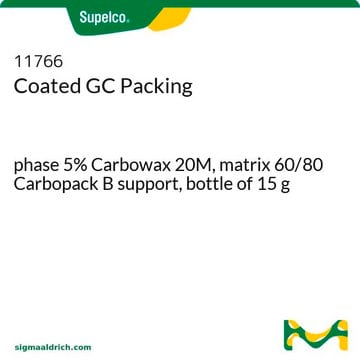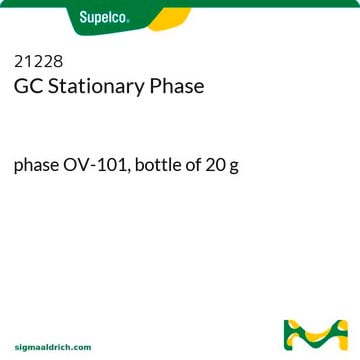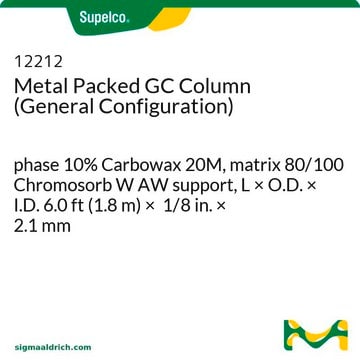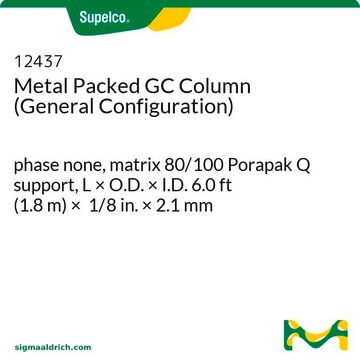21032
GC Stationary Phase
phase Carbowax 20M, bottle of 50 g
Iniciar sesiónpara Ver la Fijación de precios por contrato y de la organización
About This Item
Código UNSPSC:
23151817
Productos recomendados
Agency
meets requirements for USP G16
formulario
solid
envase
bottle of 50 g
Parámetros
60-225 °C temp. range
técnicas
gas chromatography (GC): suitable
grupo activo de la matriz
Carbowax 20M phase
solubilidad
chloroform: soluble
constante de McReynolds
17, 86, 48, 69, 56
tipo de columna
packed GC
Categorías relacionadas
Descripción general
GC methods are divided into two classes depending on the nature of stationary phases; gas-solid chromatography (GSC) and gas-liquid chromatography (GLC). GSC has solid adsorptive material and solute particles are removed from mobile phase by electrostatic forces. GLC has a thin layer of liquid coated or bonded on the surface of an inert particle or on the walls of the column where solute particles are retained in the liquid phase based on their partition coefficients. The primary necessity of a stationary phase is to provide sample separation sustaining phase integrity over a reasonable period of time. It should be stable for the chemical and thermal changes. Selectivity, peak symmetry, analysis time, degree of separation, peak tailing are few parameters that should be considered before choosing a stationary phase. Carbowax 20M is a polar liquid phase suitable as stationary phase for gas chromatography. It consists of two units of (HC2-CH2O)600 with OH terminals connected through a hydrophobic portion. This structure of the polymer makes it suitable for being used as a solvent for polar molecules such as cyclodextrin derivatives. It exhibits good selectivity toward alcohols, diols and aromatic isomeric molecules.
Synthesized specifically to be purer, of narrow molecular weight range, and without trace catalysts or impurities for use as a GC stationary phase.
Aplicación
Carbowax 20M may be used to test different relative amounts of crosslinking reagents by coating the inner wall of the capillary, to optimizing the capillary column performance.
Código de clase de almacenamiento
11 - Combustible Solids
Clase de riesgo para el agua (WGK)
WGK 3
Punto de inflamabilidad (°F)
Not applicable
Punto de inflamabilidad (°C)
Not applicable
Choose from one of the most recent versions:
Certificados de análisis (COA)
Lot/Batch Number
Sorry, we don't have COAs for this product available online at this time.
If you need assistance, please contact Atención al cliente
¿Ya tiene este producto?
Encuentre la documentación para los productos que ha comprado recientemente en la Biblioteca de documentos.
Jaiver Osorio Grisales et al.
Journal of chromatography. A, 1216(40), 6844-6851 (2009-09-01)
This paper reports the study of poly(oxyethylene) as a solvent for heptakis(2,3,6-tri-O-methyl)-beta-cyclodextrin (PM-beta-CD) and the potential of these mixtures for constructing enantioselective gas chromatography columns. Enantioseparations of volatile racemic mixtures using capillaries coated with 10-50% PM-beta-CD diluted in Carbowax 20M
George Charalambous
Chemistry of foods and beverages: Recent developments, 76-76 (1982)
Michael Gratzel
Energy Resour. Photochem. Catal. (M. Gratzel, ed.) (1983)
Nuno I P Valente et al.
Sensors (Basel, Switzerland), 18(8) (2018-07-26)
Cheese prepared from whole milk, raw and pasteurized, were analysed by an electronic nose based on piezoelectric quartz crystals and an electronic tongue based on potentiometric sensors, immediately after their preparation and along ripening (after 7 and 21 days). Whey
David B. Troy, Paul Beringer
Remington: The Science and Practice of Pharmacy, 605-605 (2006)
Nuestro equipo de científicos tiene experiencia en todas las áreas de investigación: Ciencias de la vida, Ciencia de los materiales, Síntesis química, Cromatografía, Analítica y muchas otras.
Póngase en contacto con el Servicio técnico



